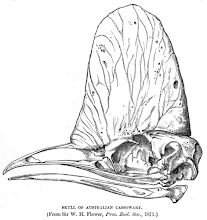Warning: I want to address a theory on the evolution of feathers, but I have to reach Way-Back-In-The-Good-Days-Before-Even-Dad-Was-Born to do so. Don't worry, dinos rule!
Check it:

This is a Dromeosaur. It is a dinosaur from the clade [dur] Dromaeosauridae. Dromaeosauridae is a sister clade to Aves, and the way I understand the relationship between a dromeosaur and its bird contemporary is comparable to the relationships between chimpanzees and their human contemporaries.

[It's not a perfectly analogous fit, so don't quote me on that one.]
what I wanted to point out on this dromeosaur are the filamentous protofeathers. The dromeosaur's feathers:
a) were used for insulation
b) did not make dromeosaurs capable of flight
and c)are [were] derived from scales!
shall we investigate point (c)?
well, okay! heEeErE we go!
reptiles have scales, some of which are classified as scutes. we know almost certainly that dinosaurs had scutes from ample evidence in the fossil record:

uh okay that looks like an old rock.
reptiles like crocodiles and turtles have them, as well as really old fish like sturgeons. it's basically a bony plate that a lot of different organisms have, like
this weird catfish

dig the ridges! like ruffles, except not a delicious salty chip!
and turtles

what a ridiculous image--there is no way somebody could simultaneously hold the full time jobs of doctor AND mailman. gEt ReAl
so scutes are found in fish and reptiles, and i'll bet you have guessed by now that scutes are also found in birds! they're the bony gross part found on birds' feet.

the reason we can call all of these structures found on all of these different animals "scutes" is because they are chemically and structurally composed in the same way:
"The β-keratins in feathers, beaks and claws — and the claws, scales and shells of reptiles — are composed of protein strands hydrogen-bonded into β-pleated sheets, which are then further twisted and crosslinked by disulfide bridges into structures even tougher than the α-keratins of mammalian hair, horns and hoof"
[thanks for wording it for me, wikipedia!]
okokokokok so... what?!
essentially, the proteins that make up the keratinized structures we know as scales and scutes have the same structure as feathers and claws! the specific protein is known as beta-keratin.

oh baby do i love molecular structures.
the "beta" in beta-keratin is just referring to the way the molecules bond to form the 3-D structure of the protein. if it is a beta protein, the structure is sheet-like, and the sheets line up in opposite directions and then bond further to ultimately form a very strong material.

so: scutes [to a point] [[that could be a weak pun]] have the same molecular makeup as feathers.
but how do we get from a hardened bony structure such as a scute to a soft pretty feather that aids in flight?
i mean, scutes are not velly cute, you know?

vs.

no competish, thing with feathers is way cuter. i swear i'm not even biased!
to determine the relation between scutes and feathers, a guy named Alan Brush conducted a study in which an inhibitor virus was introduced to bird embryos that targeted scute development. when the birds hatched, they consistently had [some] feathers and/or filaments in place of where the scutes should have developed!
woah, so scutes are just hardened feathers? how exciting!

portrayal of the brush experiment. probably accurate!
chout and watch me work, i'm going to draw a conclusion:
over time, certain scales of reptiles [scutes] developed into the filamental protofeathers of early avian ancestors like dromeaosuars. initially they were used for warmth and protection, but these feathers started to serve for a means of locomotion, and hey! it worked out. avian feathers are derived from reptilian scales.

edit: an earlier version of this post incorrectly labelled an experiment as conducted by Alan Burns. Alan Brush conducted the experiment. Alan Burns was my simpsons-filled imagination running away with me. sorry!

No comments:
Post a Comment